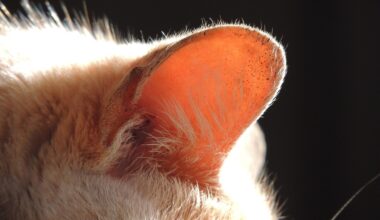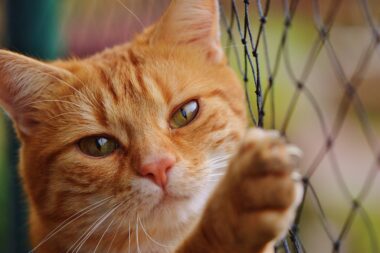The Pros and Cons of Outdoor Access for Cats and Safety Measures
Providing outdoor access for cats can have notable pros and cons. Cat owners can significantly enhance their feline’s quality of life by allowing them to explore nature. Cats are natural explorers and providing them with outdoor time can stimulate their senses. In contrast, there are many risks associated with outdoor access. Urban environments may present dangers such as traffic, dog attacks, or even other cats who may be hostile. Additionally, outdoor exposure can lead to the risk of diseases. Cats can contract parasites or infections from wildlife. Hence, pet owners must weigh these risks carefully. Some may argue that keeping cats indoors is the best solution for their safety. Nevertheless, how can the benefits of the outdoors be balanced with these dangers? Proper safety measures, including fenced yards, leash exposure, or supervised outdoor access, can be explored. Pet owners can still consider planting cat-safe herbs or building catios. A catio can transform the outdoor experience without the risks. In conclusion, understanding the full scope of outdoor access is crucial for every cat’s happiness and safety, allowing for informed decisions regarding their well-being.
One significant advantage of allowing cats outdoor access is their natural behavior being fulfilled. Cats, as natural hunters, thrive when they can engage in play that mimics hunting. These activities help prevent boredom and destructive behavior in the home. However, some pet owners may not understand the importance of supervised outdoor time or regular enrichment activities. There are creative ideas to engage indoor cats, such as interactive toys or puzzles. These alternatives can keep indoor cats mentally and physically stimulated. Additionally, outdoor access can provide essential social interaction for cats, as they can encounter other animals. However, socializing can be risky; new animals may bring health concerns or pose territorial challenges. Moreover, outdoor experiences build confidence in cats, which may lead to decreased anxiety during interactions with people or other pets. Nevertheless, it’s important to teach cats safe behavior. Training cats to respond to commands helps ensure they are always under control outdoors. Pet owners should consider their living environment and local wildlife when assessing outdoor safety for cats. Understanding these factors contributes to optimal decision-making for happy and healthy feline lifestyles, integrating outdoor exploration and necessary precautions.
Health Considerations for Outdoor Cats
Outdoor cats may face various health risks compared to their indoor counterparts. Disease exposure is a significant concern for owners who let their cats roam. Common ailments include feline leukemia, feline immunodeficiency virus, or parasites like fleas and ticks. Regular veterinary visits can help detect and prevent these issues. Moreover, it’s essential to vaccinate outdoor cats diligently according to the veterinarian’s guidelines. Providing a balanced diet and sufficient hydration also plays a critical role in their health. Unfortunately, free-roaming cats face dangers beyond disease; they are at risk of injury from vehicles or predators. Pet owners can consider alternative methods of allowing outdoor time safely while managing the associated risks. Creating secure play areas, such as a catio, ensures safety while offering outdoor enrichment. It’s crucial to supervise outdoor play to quickly manage any potential hazards. Furthermore, understanding local wildlife interactions is beneficial. Cats should be spayed or neutered as well to prevent overpopulation and reduce territorial behaviors. Good health practices are key in ensuring outdoor cats maintain strong immune systems while lowering risks. Ultimately, responsible pet ownership directly correlates to improved health outcomes for outdoor felines.
Indoor cats generally enjoy longer lifespans. A study indicated that outdoor access tends to shorten their lives due to various risks they face outside. The dangers include predation, disease, and even severe weather conditions that can overwhelm a feline. Many owners prefer keeping their cats indoors to maximize safety. Indoor environments can be enriched with trees, climbing structures, and interactive playtime to provide mental stimulation. Owners should always ensure that indoor environments are safe and free of hazards. Awareness of toxic houseplants, such as lilies or philodendrons, must be paramount to safeguard indoor cats. Besides, utilizing window perches may allow cats to safely enjoy visual stimulation from nature without the risks. They can observe birds or squirrels, satisfying their curiosity and hunting instincts while remaining indoors. Experts emphasize that the benefits of indoor living can provide security and comfort for cats without compromising their well-being. Establishing a dedicated playtime schedule is vital. Owners can incorporate exercise routines that challenge their feline’s agility. Ultimately, each owner must assess their circumstances and preferences, leading to informed, balanced decisions to ensure a fulfilling lifestyle for their beloved pets.
Designing Safe Outdoor Spaces
Creating a safe outdoor space for cats involves careful planning and design. Options like catios or enclosed gardens provide cats the freedom to enjoy nature while minimizing risks. Catios allow for controlled interactions, letting cats bask in the sun without contacting wildlife or hazards. Many designs are available, from simple window boxes to elaborate gardens. Owners can personalize these spaces with cat trees, perches, or tunnels. Additionally, choosing safe materials in the construction of these spaces is crucial. Avoiding materials that can harm cats, such as untreated wood or sharp edges, should be priority. When planning a catio, ensure there’s adequate shade and weather protection. Cats need a safe retreat from rain, sun, and extreme temperatures. Furthermore, consider incorporating plants safely; certain herbs and shrubs are non-toxic, allowing cats to explore eclectic scents without harm. Using fencing to protect outdoor spaces should also be carefully considered—high fences or anti-climb features can help deter escapes. Vigilance is key; supervising outdoor play and ensuring adequate space protects them from potential threats. A well-designed outdoor environment not only satisfies a cat’s environmental needs but fosters an excellent relationship with their surroundings.
One notable downside to outdoor access for cats is the potential disruption to local wildlife. Cats are efficient hunters and may instinctively stalk and catch birds, small mammals, and reptiles. This habit raises concerns about their impact on local ecosystems. Many communities report a significant decline in certain bird populations attributed to uncontrolled cat colonies. Hence, responsible pet ownership involves controlling outdoor access and promoting responsible behaviors within pet owner communities. Creating aware owners who understand the importance of providing enrichment to their pets should be a priority. Solutions can include providing outdoor cat safe zones that limit hunting while still allowing physical activity. Others encourage educating owners about local wildlife and the importance of wildlife conservation. Local municipalities can implement programs to support responsible pet ownership, addressing cat overpopulation, and encouraging spay and neuter programs. By proactively mitigating risks to local wildlife while enhancing feline lifestyles, everyone can contribute positively. It is essential to balance the welfare of cats and their potential ecological impact. Understanding this dynamic fosters cohabitation between pet owners and wildlife, positively impacting everything involved while enhancing community awareness oriented towards preserving nature.
Conclusion: Balancing Risks and Benefits
In conclusion, navigating the landscape of outdoor access for cats is pivotal for their safety and well-being. It’s essential for owners to weigh the risks and benefits of giving cats outdoor freedom, considering their unique circumstances. The potential advantages, such as enriched mental stimulation and natural instincts, enhance quality of life significantly. However, responsible pet ownership must remain the focus, ensuring cats are safeguarded from dangers like traffic, predators, or diseases. Adopting control measures such as catios, monitored outdoor play, or enriched indoor environments can lead to fulfilling lives. Ultimately, every cat and every living situation is unique; understanding the specific needs and risks involved helps foster informed decisions. Techniques to balance freedom with safety can provide optimal outcomes for both cats and pet owners. Establishing a successful outdoor experience demands ongoing education and commitment to their health and happiness. Owners can create safe environments while helping preserve local wildlife through thoughtful practices. Whether keeping cats indoors or permitting outdoor access, the emphasis should always be on their well-being. The ultimate goal lies in achieving that satisfying balance enabling cats to flourish comfortably, enriching their lives while celebrating their adventurous spirits.
Enhanced outdoor access produces healthy, happy cats, improving their quality of life.





